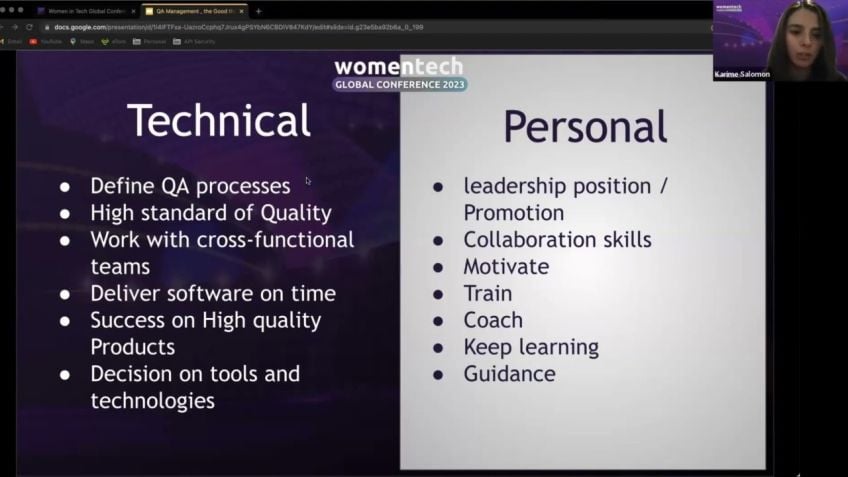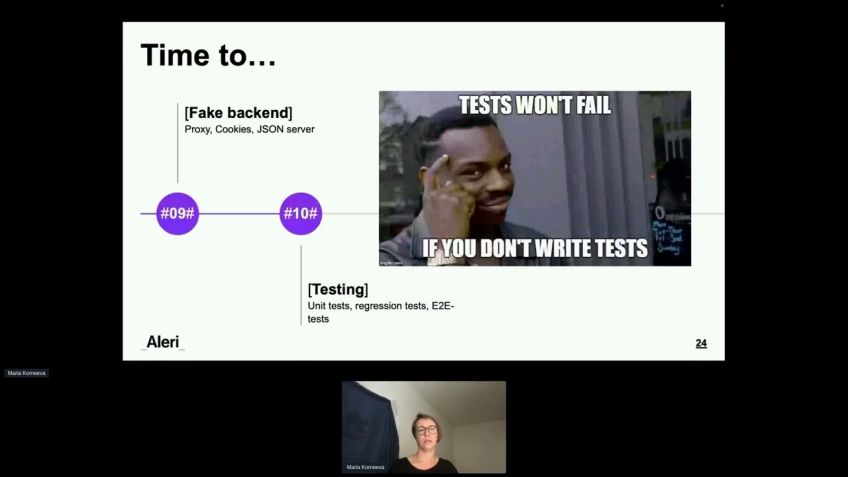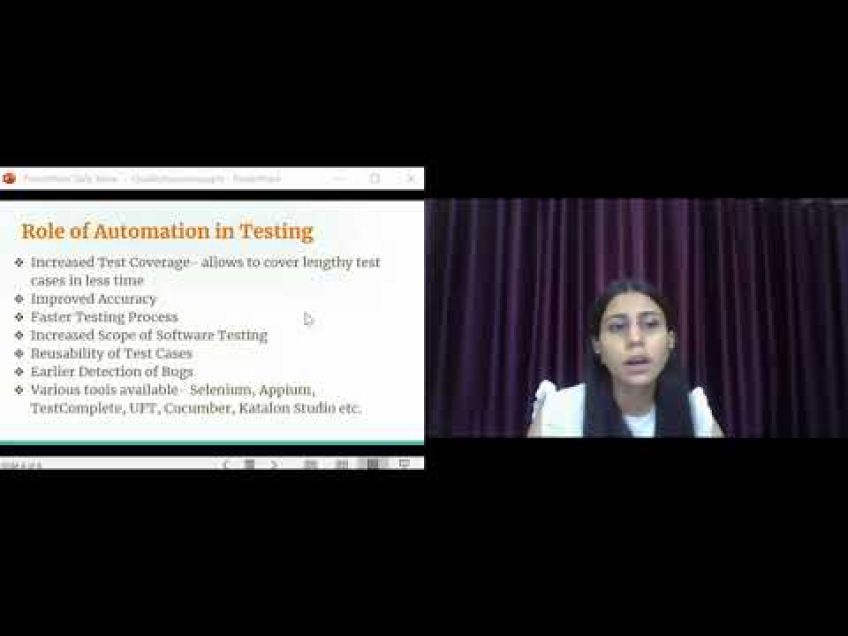Build quality culture on a scale-up environnent
Building a Quality Culture in a Scaling Environment: My Journey into QA Leadership
Hello everyone! My name is Farah and I serve as a QA strategic driver and currently hold the position of Head of QA. Over the years, I’ve learned valuable lessons about the importance of aligning a business's QA strategy to its vision. Today, I want to share my experiences about embedding a culture of quality in a scaling environment.
Starting My QA Journey
Four years ago, I joined Manga Pay as a QA assurance expert. This marked the beginning of my professional career. I was thrilled to be working alongside a supportive QA Manager, who was both a mentor and a confidant. However, a sudden departure from the QA Manager thrust me into a fast-paced environment where I found myself the only QA expert working with over 20 people.
Redefining My Purpose and Role
Suddenly, my priorities shifted, and I had to define my role and purpose within the company. As a QA professional, it would be easy to say that I was there to test. However, I found myself contributing in various capacities from specification questioning to incident management. From that moment, I was inspired to bring real value to the company by being a pioneer of true product quality.
Understanding The Landscape
Over the next three months, I started studying the different teams, asking questions, observing their activities, and taking notes about their challenges and difficulties. During this phase, I learned the importance of constantly mapping the context to identify areas where change was more than needed — it was intrinsic for the business's survival and growth.
Implementing Changes and Moving into Leadership
Six months into my journey, I felt a shift in the team's perception of me. I was no longer just observing; I was being included and notified of issues. It was at this turning point that the CEO offered me the position of Head of QA.
Before accepting, I expressed the importance of aligning my role with my vision, leading me to propose a roadmap for the QA team, organization, and objectives. By doing so, I aimed to produce a roadmap aligned with the company's vision.
Constructing a Project Roadmap
One challenge I faced at this juncture was how to strategize projects within a rapidly changing environment, like the one we found ourselves in Manga Pay. It was here that I discovered two critical goals:
- Reducing the time to market from 30 days to 24 days
- Detecting all critical external service incidents
Note: I aimed to set an achievable goal. Small victories often precede big changes and this mindset helped me create my project timeline and organization roadmap.
In the end, my implementation strategy was successful - my roadmap had company buy-in, and I felt confident that my role as Head of QA was aligned with my vision and strategy for the QA department.
Adapting to Change and Implementing Practices
Throughout my tenure, I've learnt that being aware of the company's fast-paced changes is crucial. It allows for the highlighting of opportunities and adjustment of processes to best suit an evolving environment. Notably, we had to undertake the significant task of migrating our deployment chain.
The Evolution of Quality Assurance
In the current phase of our QA journey at Manga Pay, we've integrated different activities into our scope, such as specification review, automation, and incident management. Furthermore, we've moved from a single QA person for nine developers to a full-featured QA department. A testament to the development and implementation of our quality culture!
Conclusion
Being part of this change and growth at Manga Pay has been fulfilling. We've achieved the deployment of a quality culture at all stages and I look forward to the continued evolution of the QA role within the industry.
Thank you for reading, and please feel free to connect with me on LinkedIn and Twitter for further discussions.
Video Transcription
Hello everyone. Um I'm happy to be there today. And before maybe starting, let me introduce myself.So I'm Farah and I am a Q A strategic driver as head of Q A today, I will share with you my experience about uh building a quality culture in the scale of environment. My story began four years ago. So four years ago, I joined a company uh called Manga Pay as an expert uh quality quality assurance expert. It was the start of my professional career and I was so happy to join the Q A manager as a leader that I could rely on, but also that could support me in my journey. But three months later, the Q A manager left and I found myself the only Q A expert working with more than 20 people from uh developers, product uh but also supporting and with this unexpected situation, priority changed for me. And the first question was to find my purpose and being able to move uh in, in the right uh the right direction. So why am I here?
What is my added value for my stakeholders, for the company and for the business as a Q A, the answer can be easy. You are here for testing. But for me, it doesn't really make sense because I found myself contributing from specification questioning to incident management. And in reality, if a company needs a Q A, it's mainly to be able to be a pioneer and stand out with real products. And this can be brought by different activities. From that moment, I found my purpose and I started to, to, to be interested in very uh things that can contribute to this perspective. So for the next three months, I started asking uh the different teams uh uh questions, observing their activities, uh taking notes about the challenges and difficulties. One of my convents, it's uh about changing that changing. It's all about mapping the context uh constantly and seeing where the fitness of landscape is such that the energy cost of change could be less that uh than the energy cost of staying as we are. So here, an example in 2018, I observed that wherever an incident occurred on the external service side, the process was not very smooth and the teams wasted a lot of time looking for the root goes.
When I asked the product team, how can we identify if the problem is on an external service side? They said you can check the external service status page, it could be on it. Uh While the operation teams told me that we could split it with uh connectivity monitoring. So here I get to answer and the answer were were different. So I learned that such a process had to be global and centralized. Neither team is responsible for external service quality, but they are highly impacted and they were very tired of the situation. So the landscape here is really ready for change. During this phase, I contributed uh a lot and I continue to work with determination. And in accordance with my vision, I initiate some changes from the opportunity I observed like, like this opportunity and some of them were successful, six months have passed the project opening. And the good news is that the team are starting to including me more and more in the subject on which I have been asking questions and informing, informing me. So I am moving from observation phase and posture to a notification posture. And this is really a good news because it means that the observation phase went well. At the same time, the CEO uh came to see me and offered me the position of head of care.
I was delighted and the first thing I said to her was so uh before acting the job, I want to give you my vision. So give me a month and I will propose a roadmap. If we all agree on it, I will accept the job. Otherwise I may not be the right person for it. The idea here is was to translate my observations and vision into a team proposal with a career missions, a structured organization, but also an objective roadmap. If I took the opportunity without uh that uh first job, I wouldn't have been confident that I had that I was on the right path in terms of vision and that the CEO would support the beliefs I hold for me, I think that change requires alignment. So now that I have an idea of what I want uh to be, thanks to my reflections and I have uh taken notes on what to improve and how I am full of plan to build a road map. But the problem is uh with a lot of idea and only six months in a contis continuously changing environment because we are on a scale up. It is very hard to know how long the project will take, how complex they are and how much teams member and expertise are needed. So at that stage, I decided to concentrate on the point that seems to me to be the most important.
First, I have noticed that the time to market was more than four weeks. And so the company, uh the co the company's ability to be a pioneer was affected. The second thing I had also in mind, the speed at which teams were developing and the need to be able to make them autonomous on the processes to gain proactivity. Uh As for example, uh the incident, the incident management for external services. So from there, I set out with two objectives for the first year. The first one, improving the time to market from 30 days to 24 days. And the second one detects 100% of the most critical external service. As you can see, the goal remains modest. I was not looking to achieve the impossible from the start. And the idea is to aim for something val and achievable. Small victories often precede big changes. With this goal. I set a project and align them with the timeline and organization. Good for me. Now, my roadmap is ready. I have a powerpoint to support it. It's up to me to experiment it uh For, for, for my teammates, the fact is I could never claim to know all the truth in a company. There, there are multiple roles which with each uh one vision, uh interest and expertise. So I identified a few key people from all level between product developers, sea level.
And I presented my speech and strategy and the exercise was very, very interesting for me because I could first train myself then observe their reactions and how they welcomed my presentation. And finally, I could note their questions and remarks. At the end of the third try, my vision was completed enriched by their feedbacks and my speech become more and more unifying with a global vision. And here we are, the month of delay is coming to an end. We are September 2018. And I think I'm ready, but I was very, very stressed to be able to make my idea working. And uh before going to see the CEO, I decided to call a friend to tell him the story and asking for advice. At that moment, he told me something very true and that will mark me forever. He said, Farah, cu want to hear what you bring to the company and not what it bring to you or only to the teams. It's about business. OK. Interesting. This sentence resonates a lot with me. So I changed my speech to oriented in this sense. One of the objectives of the company this year was to do more than 50 release uh per year. I alienate my department uh and a project goal with that and we are on on D day, everything went incredibly well.
The fact that is most of the questions the CEO asked me had already been asked during the experiment, the experimentation phase and my speech resonate and I got the go. This is the good news. So as of the end of 2018, I start by executing my strategy from recruitment to project implementation. But in scale up, everything changed at full speed and its evolution sometimes promote change that we did not plan. In 2018 19, the operation teams had planned an infrastructure migration.
So I become asking questions as forever and uh discussing with head of Q A and uh the head of operations and uh also head of developer and we realized that we had to migrate our entire deployment chain, an excellent opportunity to reinforce uh processes uh with the best practices of the industry and ensure better quality for uh production deployment.
So from staging phase to Canary phase, I initiate the project with the team, we promoted to the CEO no more work for the teams and yet agreed to again for us, we succeed in making our deployment process more robust. Of course, the project was not planned, but the project had sense for the improvement of the time to market. So it had sense for us. And what I have learned is that it's good to be aware of change to highlight opportunities. Every situation is good for something. If you are able to see the best in it, sometimes we are afraid to take actions, afraid to not be the expert or not making the right decision. However, change requires courage. In two year, the role of quality has changed the comp at at the whole company level and the teams have been able to change their attitude. And when I arrived, we were at the end uh o of of the line on certain subjects such as specification review. Uh And in six months, we started to be notified before the development phase. In a year, we started to have a clear role with the processes on this subject. And the teams automatically consult us before each development, our feedback in which division point out the problems was sometimes taken into account into account and sometimes not. And it was not a problem.
It's also that the part of change after two years, no specification could pass to the development phase without our goal, the team has become aware of the necessity of our contribution. I would have liked to move on this posture from the day one, but Rome was not built in a day. And as I moved into a leadership position, my role become more and more about creating the condition in which good things can happen and acting as a catalyst when the conditions are needed for change. What you can see here is our history. In 2018, we uh we, we, we had only two activities ma mainly automation and observable. And from there we uh we added some missions and in 2021 we got specification review, automation, observable incident management and a lot of others mission. And this is really interesting because we left from one Q A for nine developer to a whole Q A department. Uh that, that is now part of one of the direction uh committee which is operation committee, but also leading an incident uh management committee. So it was all for me today about uh how I achieved uh that the fact that the culture of quality is now deployed at Man Cave and all stages stages. Uh Thank you for listening. Uh And I'm waiting for uh your question.
If you have some, you can find me on linkedin and on uh in Twitter if you want. Thank you.





